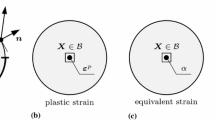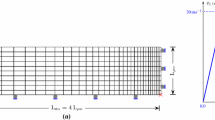Abstract
In the Gurson-Tvergaard model a failure criterion has to be used to signify the void coalescence. In the literature, a constant critical void volume fraction criterion has been widely used. However, it is questionable whether the critical void volume fraction is a material constant and, furthermore, it is also difficult in practice to determine the ‘constant’. By modifying Thomason's plastic limit-load model, a new failure criterion which is fully compatible with the Gurson-Tvergaard model, is presented in this study. In the present criterion, the void coalescence failure mechanism by internal necking has been considered and the material failure is a natural result of the development of dual constitutive, stable and unstable, responses. In practical application of the present criterion, no critical void volume fraction needs to be pre-determined either numerically or experimentally. Furthermore, according to the new criterion, the void volume fraction corresponding to void coalescence is not a material constant, rather a function of stress triaxiality. The predictions using the present criterion have been compared with the finite element results by Koplik and Needleman, and very good agreement is observed. The potential advantage of this criterion and other related issues are discussed.
Similar content being viewed by others
References
G. Rousselier, Nuclear Engineering and Design 105 (1987) 97–111.
J. Delmotte, J.M. Roelandt and A. Abisror in Proceedings of the 5th International Conference on Numerical Methods in Fracture Mechanics, April, 1990, A.R. Luxmoore and D.R.J. Owen (eds.) Pineridge Press (1990) 631–643.
B.A. Bilby, I.C. Howard and Z.H. Li, Fatigue and Fracture of Engineering Materials and Structures 16 (1992) 1–20.
C.L. Chow and J. Wang, International Journal of Fracture 38 (1988) 83–102.
Y. d'Escatha and J.C. Devaux, ASTM STP 668 (1979) 229–248.
A.L. Gurson, Ph.D. dissertation, Brown University (1975).
A.L. Gurson, Journal of Engineering Materials and Technologies 99 (1977) 2–15.
V. Tvergaard, International Journal of Fracture 17 (1981) 389–407.
V. Tvergaard, International Journal of Fracture 18 (1982) 237–252.
V. Tvergaard and A. Needleman, Acta Metallurgica 32 (1984) 157–169.
J. Hutchinson, Micro-Mechanics of Damage in Deformation and Fracture, The Technical University of Denmark (1987).
A. Needleman and V. Tvergaard, Journal of Mechanics and Physics of Solids 35 (1987) 151–183.
N. Aravas and R.M. McMeeking, International Journal of Fracture 29 (1985) 21–38.
R. Narasimhan, A.J. Rosakis and B. Moran, International Journal of Fracture 56 (1992) 1–24.
J. Koplik and A. Needleman, International Journal of Solids and Structures 24 (1988) 835–853.
V. Tvergaard, in Advances in Applied Mechanics, J.W. Hutchison and T.Y. Wu (eds.) Academic Press (1990) 83–151.
Y.W. Shi, J.T. Barnby and A.S. Nadkarni, Engineering Fracture Mechanics 39 (1991) 37–44.
R.D. Thomson and J.W. Hancock, International Journal of Fracture 26 (1984) 99–112.
D.Z. Sun, D. Siegele, B. Voss and W. Schmitt, Fatigue Fracture Engineering Materials and Structures 12 (1989) 210–212.
D.-Z. Sun, B. Voss and W. Schmitt, in Defect Assessment in Components — Fundamental and Applications, ESIS/EGF9, J.G. Blauel and K.-H. Schwalbe (eds.) Mechanical Engineering Publications, London (1991) 447–458.
P.F. Thomason, Ductile Fracture of Metals, Pergamon Press, Oxford (1990).
P.F. Thomason, Acta Metallurgica 33 (1985) 1087–1095.
P.F. Thomason, Acta Metallurgica 33 (1985) 1079–1085.
Z.L. Zhang and E. Niemi, Engineering Fracture Mechanics 48 (1994) 529–540.
J.R. Rice and D.M. Tracey, Journal of Mechanics and Physics of Solids 17 (1969) 201–207.
J. Sun, Engineering Fracture Mechanics 39 (1991) 799–805.
C.C. Chu and A. Needlman, Journal of Engineering Materials and Technologies 102 (1980) 249–256.
ABAQUS User's Manual, V5.2, Hibbit, Karlsson & Sorensen, Inc. (1992).
Z.L. Zhang and E. Niemi, International Journal for Numerical Methods in Engineering, accepted.
Z.L. Zhang and E. Niemi, Fatigue and Fracture of Engineering Materials and Structures 17 (1994) 695–707.
Z.L. Zhang, Ph.D. dissertation, Lappeenranta University of Technology (1994).
Author information
Authors and Affiliations
Rights and permissions
About this article
Cite this article
Zhang, Z.L., Niemi, E. A new failure criterion for the Gurson-Tvergaard dilational constitutive model. Int J Fract 70, 321–334 (1994). https://doi.org/10.1007/BF00032450
Received:
Accepted:
Issue Date:
DOI: https://doi.org/10.1007/BF00032450




